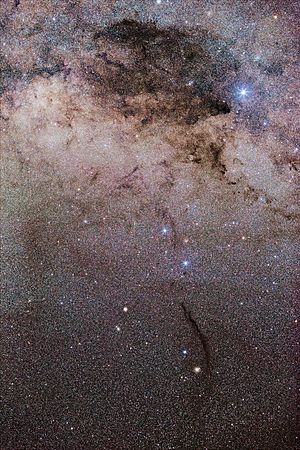Coalsack nebula facts for kids
The Coalsack dark nebula, often just called the Coalsack, is a very famous dark nebula in our sky. You can easily see it without a telescope! It looks like a dark patch against the bright southern Milky Way.
People in the Southern Hemisphere knew about it long ago, even before written history. A explorer named Vicente Yáñez Pinzón saw it in 1499. The Coalsack is about 600 light years away from Earth. It is found in the constellation Crux, which is also known as the Southern Cross.
What is the Coalsack Nebula?
The first time someone officially wrote about the Coalsack was in 1499. This was done by Vicente Yáñez Pinzón. People sometimes called it the "dark Canopus" or "Magellan's Spot." It was also known as the "Black Magellanic Cloud." This was because it looked like the opposite of the bright Magellanic Clouds.
In 1970, scientists learned that the Coalsack is not completely black. It actually has a very faint glow. This glow is about 10% as bright as the surrounding Milky Way. The light comes from stars that are hidden behind the nebula. Their light reflects off the dust and gas in the Coalsack.

The Coalsack is very important in Australian Aboriginal astronomy. It forms the head of the Emu in the sky. This is a special constellation in several Aboriginal cultures. For example, the Wardaman people believe it is the head and shoulders of a "law-man." This law-man watches over people to make sure they follow traditional rules.
In Inca astronomy, this nebula was called Yutu. This word means "a partridge-like southern bird" or Tinamou.
The Coalsack in Stories and Movies
The Coalsack has appeared in many science fiction stories and films. It is often used as a mysterious or dangerous place in space.
- In Star Trek: The Original Series, the Coalsack is mentioned in episodes like "The Immunity Syndrome" and "Let That Be Your Last Battlefield".
- It is also in 2001: A Space Odyssey by Arthur C. Clarke.
- In the Solar Queen book series by Andre Norton, characters sometimes say, "...by the Coalsack's Ripcord!"
- The Coalsack is a big part of the Larry Niven and Jerry Pournelle's science fiction novel The Mote in God's Eye. It also appears in its sequels.
- Henry De Vere Stacpoole wrote about the Coalsack in his 1908 novel The Blue Lagoon.
- The Coalsack is mentioned in the Futurama episode "Hell Is Other Robots".
- In the film Night on the Galactic Railroad, a character named Campanella travels to the Coalsack.
- In the movie The Chronicles of Riddick, the character Imam tells Riddick that "The Coalsack planets are gone."
- Brian J. Clarke's story The Expediter describes a world of strange towers "behind the Coalsack."
Images for kids
-
The dark Coalsack Nebula looks like a smudge across the Milky Way.
See also
 In Spanish: Nebulosa Saco de Carbón para niños
In Spanish: Nebulosa Saco de Carbón para niños



